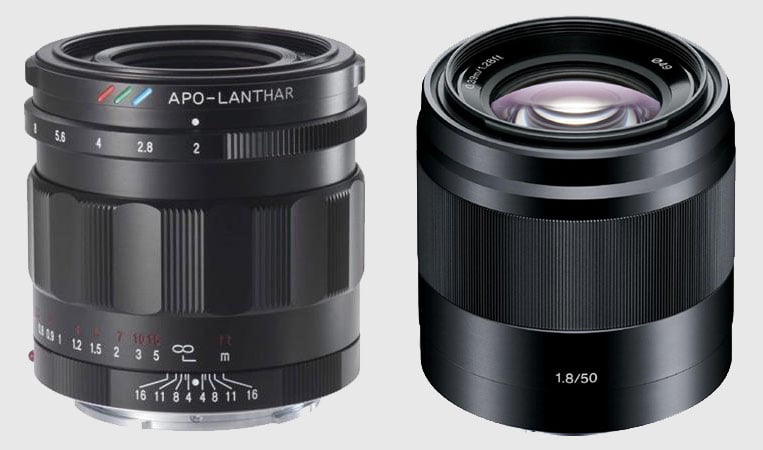![]()
Many of us enjoy quality. Be it a car or a lens, there’s a pleasure in using quality things. And in the case of lenses, how perceivable is the quality of the images captured?
The research for this article was prompted by my “lust” for the Voigtlander 50mm f/2 Apo Lanthar. Phillip Reeve has written that it’s one of the sharpest lenses we can buy. I wondered if I would perceive that sharpness compared to my inexpensive Sony 50mm f/1.8 OSS lens.

The mosaic below is comprised of six 745×620 pixel images cropped from the center of full frames shot with a Sony a7R IV producing 9504×6336 pixel full frame images. Each panel is only 7.8% of the full frame width (click to enlarge).
The panels were shot with a Sony 90mm f/2.8 Macro, which is one of the best available lenses for my camera. Each panel was shot at the aperture printed on the panel. The MTF resolution that opticallimits.com reported for each aperture is given below. As usual, diffraction degrades the image as the aperture size decreases.
![]()
If each panel is about six inches wide on your computer screen, that would correspond to pixel peeping a full frame print 76 inches wide. You would be peeping at that huge print from the same distance that you are now viewing your computer screen, perhaps about 18 inches.
The lowest resolution is the f/22 panel in the bottom right corner. Opticallimits.com reported a diffraction-limited MTF of only 2389 line pairs at this aperture. Up close, you can see that this panel is softer than the f/16 panel to its left, which has an MTF of 3423. Now move away to find the distance where you can’t perceive a difference between the two lowest panels. For me, that distance is 24 inches.
Although lens reviews often report diffraction degrading resolution beginning at f/11, I don’t perceive any difference in any of the panels from the best f/4 (top left) down through f/16 (bottom left). Perhaps you can see a difference, but I’ll wager we agree that they are very close.
And, of course, when we view a photo, we aren’t comparing two versions of the same image. We view the image alone. Below is the full frame shot at f/22, resized to 1500 pixels wide for the internet. Viewed in isolation, it looks sharp to me.
![]()
You can download the full 24mb image here.
What if we crop 1500 pixels out of this image?
In an article published a few months ago, I demonstrated zoom by cropping. This 9504-pixel-wide frame allows 6x zoom by cropping. Surely we want to start with a sharp image if we’re cropping 6x. Yet it appears to me that even the worst f/22 image is sharp enough. The pic below is 1500 pixels cropped out of the f/22 image.

Viewed in isolation, it’s pretty nice. Yet it was captured with a lens set at an MTF of only 2389.
Now view the 1500 pixel crop, taken from the center of the sharpest f/4 frame which was shot with an MTF of 5002, more than twice as high as the f/22 image.

When you view the images separately, are you aware of any difference in sharpness? I see a difference, but the f/22 image can be easily sharpened. Here is the sharpened version.
![]()
What about the edges?
The accepted definition of an excellent lens is one that’s sharp at large apertures in the center and the edges. But, as I’ve mentioned in some of my recent articles, we usually want the edges as soft as possible when shooting at large apertures.
When we do want sharp edges, we also want depth of field. And even mediocre lenses have sharp edges at f/11 or f/16 which we choose for depth of field.
An exception, rare for most of us, is an architectural photo of a building façade, which doesn’t need depth of field. But of course, we can shoot this at f/11 or f/16 to capture sharp edges. The building isn’t moving, so we don’t need to freeze it with f/2.
Summary
Like many of us, I’ve long lusted for sharp lenses. But this experiment is tempering my lust because it revealed that I’ll rarely perceive the difference between an excellent lens and a mediocre one.
Read also: Perfect is Boring: Lens Makers Need to Loosen Up and Have Fun
This work also showed me not to worry too much about diffraction in non-macro photos. Sometimes the depth of field of small apertures is more important than slight softening due to diffraction. The photo below was shot at f/22.
![]()
But for macro photos, be warned that diffraction is much more serious.
About the author: Alan Adler lives in Los Altos, California. The opinions expressed in this article are solely those of the author. He has been an avid photographer for 60 years. He is also a well-known inventor with about 40 patents. His best-known inventions are the Aerobie flying ring and the AeroPress coffee maker.
Image credits: Header illustration eye stock photo licensed from Depositphotos
Author: Alan Adler
Source: Petapixel



